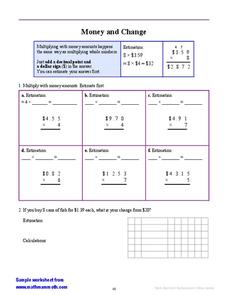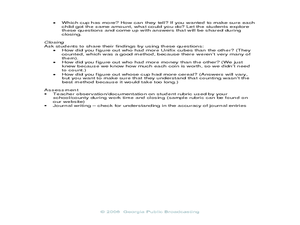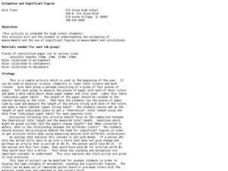Curated OER
Fancy Foot- Estimating Whether a Line is Longer or Shorter Than a Foot
In this fancy foot estimation and measurement worksheet, 1st graders examine 3 curved lines and estimate whether they are longer or shorter than a foot. They use a foot-long string to check each answer.
Curated OER
Making Estimations in Measurement
Students utilize their knowledge of measurement in making accurate measurements and estimations.
Curated OER
Problem-Solving Skill: Is an Estimate Enough?
In this problem-solving skills instructional activity, students learn how to determine whether or not an estimate is enough when solving a problem. They then use this skill to solve the 2 questions at the bottom of the page.
EngageNY
Sampling Variability in the Sample Mean (part 2)
Reduce variability for more accurate statistics. Through simulation, learners examine sample data and calculate a sample mean. They understand that increasing the number of samples creates results that are more representative of the...
Curated OER
Five Second Dash
Students estimate how far they can run, jump, or hop in five seconds, then check their prediction. In this estimation lesson plan, student predict how far they can run, hop, or jump in five seconds and then try it.
Curated OER
Solving Problems
Second graders become familiar with need strategies for computation of money problems and estimating sums. In this computation lesson, 2nd graders solve real life problems to understand estimation and money problems.
Curated OER
Pancakes, Pancakes!- Measuring
Students estimate measurements in real world problem situations. For this estimation lesson, students read the book Pancakes, Pancakes and estimate how many cups equal a pint, quart, and gallon. Students test their estimations by...
Math Mammoth
Money and Change
In this consumer math activity, students estimate and then multiply the given money amounts. Students also practice finding change. There are seven problems to complete.
Curated OER
More! A Lesson on Comparing
Students practice counting and comparing objects. In this math lesson, students view a Count on It! episode. Students examine the value of what they are counting. Students estimate number in groups of items. Students determine which...
Curated OER
Object Graphs
Students identify geometric shapes, demonstrate construction of an object graph, compare sets of objects, estimate which student has the most geometric shapes in his or her bag, and play computer game Jump Start Kindergarten.
Curated OER
Mountain Math Worksheet
In this number sense instructional activity, 5th graders solve 37 problems based on a given number. Students are asked to round the number, identify the number as even or odd and add 100 to the number.
Curated OER
Estimation and Significant Figures
Students investigate the importance of significant figures through measuring and estimating. In this estimation and significant figures lesson plan, students measure pieces of paper and round their figures to the nearest marking on the...
Curated OER
Squares and Square Roots
Students find patterns relating the lengths of the sides of squares to their areas. In this squares and square roots lesson, students draw squares and find their areas. They estimate the sides of square when given the area. Students use...
Curated OER
Estimating Weight: Kindergarten Activity
In this weight worksheet, students choose the answer that is the closest to the actual weight of an object shown in a picture, writing the weight beside each. A reference web site is given for additional activities.
Curated OER
In the Ballpark
Middle schoolers practice estimation skills with the video series "Interactions: Real Math, Real Careers". They complete a hands-on activity for estimating large numbers.
Curated OER
Comparison of Snow Cover on Different Continents
Students use the Live Access Server (LAS) to form maps and a numerical text file of snow cover for each continent on a particular date and analyze the data for each map, corresponding text file to determine an estimate of snow cover for...
Curated OER
Estimating for Accuracy
Middle schoolers are introduced to the topic of estimation. Using various methods, they estimate and calculate the answers with the use of a calculator. They develop a practice to always estimate answers involving percentages and use a...
Curated OER
All About Aid
Begin this lesson by estimating the cost of a college education and comparing it to actual data. After reading an article, high school seniors discuss the processes of the college loan corporations. They listen to a lecture about how to...
Curated OER
Probability Games and Activities, Unit 10
Looking for tangible ways to practice probability with your class? Through 4 activities, students practice with experimental probability, using math to make educated guesses, then testing it through physically completing the experiment....
NTTI
Putting Together Ten
Groups explore sets of 10 items in two varieties (i.e. 3 white buttons and 7 black ones, or 5 bears and 5 bunnies). They brainstorm about their objects, write math sentences to represent what they have, and report their discoveries to...
Illustrative Mathematics
High School Graduation
An exercise in finding the approximate time that a name would be called at a graduation. Estimating time may be difficult for some of the class, so this resource would not be a good choice for learning this standard. It does end with a...
Curated OER
Valentine Marbles
if you've ever had to guess how many items were in a jar, then this problem is for you! With a big jar full of red and white marbles, does picking a sample of 16 allow your learners to get a good estimate on the percentages of each...
Curated OER
Measuring Pumpkins and Our World
Students estimate the circumference of a pumpkin. They measure the pumpkin and other school objects, and record the measurements on worksheets.
Indiana Science
How Many E’s?
Seventh graders explore random sampling by estimating the number of e's on the newspaper. They explain the possible error sources for this type of sampling, and compare the accuracy of sampling a small and large population. This is a...

























